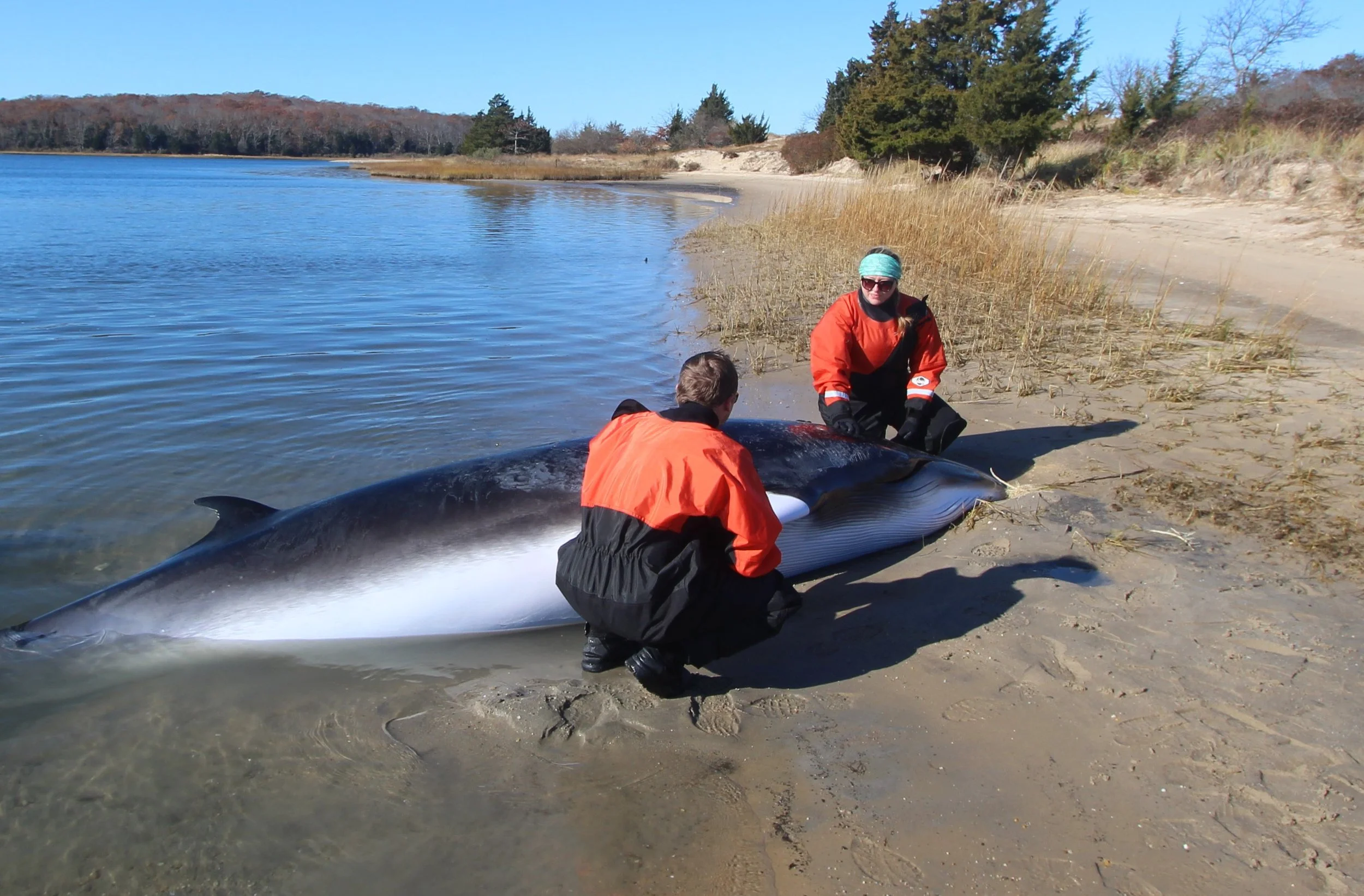You may have seen AMSEAS on the beaches during our stranding investigations, whether responding to live stranded animals or conducting necropsies (animal autopsies) on deceased marine mammals and sea turtles. But did you know that our work begins long before our team sets foot on the beach?
Our investigation starts as soon as the phone rings alerting our team to a stranding via the NYS 24-hour Marine Mammal and Sea Turtle Stranding Hotline. A member of our stranding team must then put on their detective hat to gather vital information about the animal being reported to obtain a history, such as the species and approximate size of the animal, whether it is alive or dead (and if deceased, the condition of the carcass), where it is located (beached, floating/moving and in what direction), and if there are any obvious markers or identifiers on the animal. We also determine the accessibility of the animal’s location, gathering data on tides, weather, location from the nearest access point, etc.
Our next step is to contact whoever has jurisdiction over the land where the animal has stranded, and begin a coordinated effort working with local municipalities, state or federal agencies, or even occasionally homeowners. Stranding events are conducted using the Incident Command System, which allows multiple organizations to run under a unified command making a large event manageable. We work with these groups to determine logistics for a response in the case of a live animal or examination and disposal of the carcass in the case of a deceased animal. Necropsies on large animals, such as whales, are resource intensive. It requires heavy machinery such as front loaders and excavators with thumbs to move larger animals to a safe location and to help position the animal for the examination. Safety personnel are also needed to help cordon off the area and keep the examination site secure. It often takes considerable planning, time, and effort to obtain these resources, which are provided by the municipalities we partner with during these responses.
Our team implements the Long Island Sound Large Whale Response Plan (LISLWRP) when responding to large whales throughout New York State. This plan helps bring together all agencies and organizations that are vested in a large whale stranding event to communicate objectives, strategy, and tactics among the involved parties. Basic objectives always include ensuring the safety of the responders and the animals, collecting data according to best practice and protocols set forth by NOAA Fisheries, and disseminating information to the appropriate agencies. What may seem like a “simple necropsy” on the beach in actuality often requires many hours of planning and coordinating resources in order to get our team onto the beach. This process is only made more doable by following the structure outlined in the (LISLWRP) and implementing the Incident Command System.
If we are able to conduct an external examination and necropsy on a deceased animal, our team gathers morphometric data by taking measurements, reviews both the external and internal anatomy and documents any areas of interest (such as lesions, bruising, scarring, etc.), and collects biological samples from many parts of the animal, including skin, blubber, muscle, baleen/teeth, and internal organs. This process not only provides valuable information about an animal’s biology and life history, but also sometimes offers clues about the animal’s cause of death.
The necropsy process continues once our team is off the beach, as we must then send our preliminary findings and samples to a veterinary pathologist, who conducts microscopic evaluations and several other laboratory-based tests on the samples to produce verified diagnoses and interpretations of initial findings. While our team may have preliminary information on an animal’s health status and a suspected cause of death based on our initial visual exam, a final diagnosis or cause of death cannot be determined until diagnostic testing performed by the pathologist has been completed. This process can take several months and often involves a prolonged return time on necropsy results. A final necropsy report is compiled by NOAA Fisheries using data gathered throughout the entire process, from the initial report of the animal’s stranding to the laboratory tests conducted on the samples, and involves contributions from multiple experts working on the case. It must also be noted that a cause of death is not always possible to determine, especially when a carcass is in an advanced state of decomposition.
Our team works year-round to respond to stranded marine mammals and sea turtles, and places great value on the information that can be learned from these stranding investigations. Necropsy examinations can provide significant information regarding the health of an individual animal, the species, and the larger ocean environment. Marine mammals in particular are well-recognized to be sentinel species and are often indicators of ocean health. To learn more about marine mammal necropsy examinations, visit NOAA Fisheries’ FAQ page on Necropsies of Marine Mammals.





